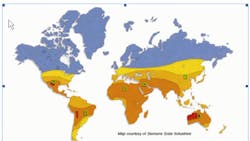In the past, power-supply designers concentrated mainly on designing devices that convert high ac voltages to stable, low dc voltages. Today, such devices perform these tasks at ever-increasing efficiencies and increased capabilities of intelligent communication with each other, to provide higher reliability power conversion.
In one of my past articles, “The Electric Grid – Now and in the Future”, I indicated that based on the recent developments and direction of the energy grid, future designs will provide new design challenges. Converting low dc voltages to the high ac voltages required by the grid, and the complexity of controlling and managing the multitude of such, remote generating locations will challenge the next generation of engineers.
The established hydroelectric, and the polluting nuclear, oil, coal and steam power-generation methods, which presently provide the bulk of the power, are gradually being augmented by clean wind and solar generators. Sun energy and wind energy – while clean and free – provide new challenges of power harvesting, power conversion and power transmission.
Power generating solar and wind locations are mainly a function of regional geography. Solar panels dominate the always-sunny southern regions of the world, as shown on the map. Meanwhile, wind turbines are ubiquitous throughout the world wherever the winds prevail.
To paraphrase Nate Lewis of the California Institute of Technology: "There is plenty of energy hitting the surface of the earth to meet the world’s entire energy needs that could totally solve humanity's energy problem."
Conversion of sunlight to high-voltage ac a is not a simple matter, as I learned during my visit this summer to Valdarno, a small hamlet south of Florence, Italy. Nestled in a small valley, the modern 180,000 ft2 Power-One facility, previously owned by Magnetek, is surrounded by hills topped with stone hamlets.
My charming host, Avelardo Farri, in his slight Italian accent, enthusiastically talked about the company’s new 97% efficient dc-ac power converter. While this article is not intended to be a travelogue or product promotion, I feel that we can all learn from some of the challenges involved in converting solar- and wind-power energy. In this column, I’ll cover what I learned about solar conversion.
The most common method of harvesting the sun’s energy is to use photovoltaic cells that convert light energy into electrical energy. The small solar cells, producing low voltages, are typically interconnected into photovoltaic (PV) modules, which in turn are connected to a large PV array that add all the low voltages to produce higher voltages of up to 360 V. Connected to the PV arrays are dc-ac inverters that convert the dc power produced by the modules into alternating current that in turn are connected to the grid.
The main challenge for designers is first to maximize the efficiency of the solar cells and secondly to optimize the conversion efficiency. The output of the PVs varies with intensity, angle of sunlight rays and cell temperatures. To optimize the conversion efficiency of the solar cells, it is necessary to operate at a voltage that will produce the maximum power. This point is commonly called maximum power point (MPP), and tracking this point is referred to as maximum power point tracking (MPPT).
MPPT is not a mechanical tracking system that “physically” moves the modules to make them point more directly at the sun. Rather, it is an electronic system that varies the electrical conversion point of the modules, so that the modules are able to deliver maximum available power.
MPPT varies the ratio between the voltage and current delivered to the system to deliver maximum power. As the voltage of the PV array varies with temperature and other conditions, it "tracks" this variance and adjusts the ratio accordingly. Such a tracking system is usually incorporated into a very efficient dc-ac converter that generates sine waves of 600 V with less than 2.5% total harmonic distortion at efficiencies in the upper 90 percentile.
This energy, transformed into ac by the inverter, is directly fed to the power distribution grid. If the energy of the PV system is not enough, to ensure standard operation, energy is drawn from the grid. When the produced energy exceeds the energy used, the difference is directly fed to the grid, thus becoming available to other users. According to national and local standards and regulations, the produced energy can also be sold to the grid or credited to the user against future consumption.
The cost of solar cells and the conversion equipment is gradually decreasing, while coal and oil prices continue to rise. So as solar and wind power generation becomes cost effective, adoption rates will increase.
In my next article, I hope to examine some of the challenges of wind-power generation which in essence is solar power converted by nature to mechanical force. I would greatly appreciate your comments, which you can send to me at [email protected].
About the Author
Lou Pechi
President, STRATA-Strategic Advisors
